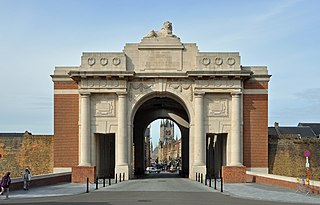
The Menin Gate, officially the Menin Gate Memorial to the Missing, is a war memorial in Ypres, Belgium, dedicated to the British and Commonwealth soldiers who were killed in the Ypres Salient of World War I and whose graves are unknown. The memorial is located at the eastern exit of the town and marks the starting point for one of the main roads that led Allied soldiers to the front line.

A war grave is a burial place for members of the armed forces or civilians who died during military campaigns or operations.

Tyne Cot Commonwealth War Graves Cemetery and Memorial to the Missing is a Commonwealth War Graves Commission (CWGC) burial ground for the dead of the First World War in the Ypres Salient on the Western Front. It is the largest cemetery for Commonwealth forces in the world, for any war. The cemetery and its surrounding memorial are located outside Passendale, near Zonnebeke in Belgium.
Polygon Wood is a forest located between Ypres and Zonnebeke, West Flanders, Belgium. It was the scene for several battles during the First World War and there are at least two cemeteries of the Commonwealth War Graves Commission in the immediate vicinity of the wood.

Larch Wood Cemetery is a Commonwealth War Graves Commission (CWGC) burial ground for the dead of the First World War located in the Ypres Salient on the Western Front in Belgium.

Ramparts Cemetery (Lille Gate) is a Commonwealth War Graves Commission (CWGC) burial ground for the dead of the First World War located in the Ypres Salient on the Western Front.

The Ploegsteert Memorial to the Missing is a Commonwealth War Graves Commission (CWGC) memorial in Belgium for missing soldiers of World War I. It commemorates men from the Allied Powers who fought on the northern Western Front outside the Ypres Salient and whose graves are unknown. The memorial is located in the village of Ploegsteert and stands in the middle of Berks Cemetery Extension.

RE Grave, Railway Wood is a Commonwealth War Graves Commission (CWGC) memorial and war grave located in the Ypres Salient on the Western Front. It is located on the Bellewaerde Ridge near Zillebeke, about 4 kilometres east of Ypres, and a little north of Hooge. The area of the Cambridge Road sector, halfway in between Wieltje and Hooge, was the site of intensive underground fighting in the First World War. The Liverpool Scottish Memorial, Railway Wood is located nearby.

Duhallow ADSCemetery is a Commonwealth War Graves Commission burial ground for the dead of the First World War located near Ypres on the Western Front in Belgium.

Hooge Crater Cemetery is a Commonwealth War Graves Commission burial ground for the dead of the First World War located in the Ypres Salient in Belgium on the Western Front. Hooge Crater Cemetery is named after a mine crater blown nearby in 1915 and located near the centre of Hooge, opposite the "Hooge Crater Museum" and separated from it by the Menin Road. Hooge itself is a small village on the Bellewaerde Ridge, about 4 kilometres east of Ypres in the Flemish province of West Flanders.

Suffolk Cemetery is a Commonwealth War Graves Commission (CWGC) burial ground for the dead of the First World War located in Kemmel in the Ypres Salient on the Western Front.

Ploegsteert Wood Military Cemetery is a Commonwealth War Graves Commission (CWGC) burial ground for the dead of the First World War located in the Ypres Salient within Ploegsteert Wood on the Western Front in Belgium.

Ridge Wood Military Cemetery is a Commonwealth War Graves Commission (CWGC) burial ground for the dead of British Commonwealth soldiers who fought in the First World War. The cemetery is in Voormezeele, West Flanders, Belgium, in the Ypres Salient of the Western Front.

The Buttes New British Cemetery Memorial is a World War I memorial, located in Buttes New British Cemetery, near the town of Zonnebeke, Belgium. It commemorates 378 officers and men of the New Zealand Division who were killed in the vicinity and have no known grave.

Buttes New British Cemetery is a Commonwealth War Graves Commission burial ground for the dead of the First World War located in the Ypres Salient in Belgium on the Western Front.

Lijssenthoek Military Cemetery is a Commonwealth War Graves Commission (CWGC) burial ground for the dead of the First World War in the Ypres Salient on the Western Front. After Tyne Cot, it is the second largest cemetery for Commonwealth forces in Belgium. Lijssenthoek Military Cemetery is located near Poperinge in the province of West Flanders. Most of those buried in the cemetery are war casualties who had been wounded near Ypres and later died in the four large Allied casualty clearing stations located in this area.

In World War I, the area around Hooge on Bellewaerde Ridge, about 2.5 mi (4 km) east of Ypres in Flanders in Belgium, was one of the easternmost sectors of the Ypres Salient and was the site of much fighting between German and Allied forces.

Messines Ridge British Cemetery is a Commonwealth War Graves Commission burial ground for the dead of the First World War located in the Ypres Salient in Belgium on the Western Front.

Zantvoorde British Cemetery is a Commonwealth War Graves Commission burial ground for the dead of the First World War located in the Ypres Salient in Belgium on the Western Front. It also contains the remains of a British airman killed during the Second World War.


















